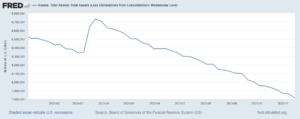The global economy faced a multitude of challenges in 2023 including Financial distress in the United States due to Rising bond yields, the war in Ukraine, Rising commodity cycles, and rising inflation. These factors contributed to a slowdown in economic growth, increased volatility in financial markets, and heightened uncertainty about the future.
Federal Reserve was relatively calm in 2023
Federal Reserve wasn’t in a hurry this year. Overall they increased rates in 4 of their monetary policy meetings, 25 basis points every time. 1 February 2023, 22 March 2023, 3 May 2023, 26 July 2023. The balance sheet reduction plan of the Federal Reserve kept on going as per plan. After failure to reach their target, 2023 saw the Federal Reserve balance sheet reduction below $8 trillion. This overall increased the effective rate in the Bond market and sent the price of the bonds tank.

Another highlight of the year was the Failure of the bank. Silicon Valley Bank (SVB), Signature Bank, Silvergate Capital Corporation, Citizens Bank, and First Republic Bank have had a significant impact on the US financial situation. These failures have eroded confidence in the financial system and raised concerns about systemic risk. PacWest Bank merged with the Bank of California.
2023 was a year of declining inflation. As of October 2023, the annual inflation rate in the United States was 3.2%. This is down from 3.7% in September and 9.1% in June 2022. The next update on inflation is scheduled for release on December 12.
The global economic outlook for 2024 remains uncertain, with risks tilted to the downside. Inflation is expected to gradually ease, but it is likely to remain above central bank targets for some time. Monetary policy is expected to remain tight, but the pace of tightening may slow. Economic growth is projected to pick up modestly, but it will likely remain below pre-pandemic levels.
Despite the challenges, there are also some positive signs on the horizon. The global economy has shown resilience in the face of adversity, and there is potential for growth in emerging markets. Technological innovation and the transition to a greener economy also offer opportunities for future growth.
As the world navigates the complexities of the post-pandemic era, agility, adaptability, and a focus on long-term sustainability will be crucial for businesses, governments, and individuals alike. By embracing innovation, fostering resilience, and promoting responsible economic growth, we can collectively shape a brighter future for the global economy.
The year 2023 was marked by a significant event in the financial world: a banking crisis in the United States. For five days in March 2023, three small-to-mid-size U.S. banks failed, triggering a sharp decline in global bank stock prices and a swift response by regulators to prevent potential global contagion.
The Failed Banks
The first bank to fail was Silicon Valley Bank (SVB). A bank run was triggered after it sold its Treasury bond portfolio at a large loss, causing depositor concerns about the bank’s liquidity. The bonds had lost significant value as market interest rates rose after the bank had shifted its portfolio to longer-maturity bonds. The bank’s clientele was primarily technology companies and wealthy individuals holding large deposits, but balances exceeding $250,000 were not insured by the Federal Deposit Insurance Corporation (FDIC).
Silvergate Bank and Signature Bank, both with significant exposure to cryptocurrency, also failed amid turbulence in that market.
In response to the bank failures, the three major U.S. federal bank regulators announced in a joint communiqué that extraordinary measures would be taken to ensure that all deposits at Silicon Valley Bank and Signature Bank would be honored1. The Federal Reserve established a Bank Term Funding Program (BTFP) to offer loans of up to one year to eligible depository institutions pledging qualifying assets as collateral.
To prevent the situation from affecting more banks, global industry regulators, including the Federal Reserve, the Bank of Canada, the Bank of England, the Bank of Japan, the European Central Bank, and the Swiss National Bank intervened to provide extraordinary liquidity.
The Aftermath
By March 16, large interbank flows of funds were occurring to shore up bank balance sheets and some analysts were talking of a possibly broader U.S. banking crisis1. The Federal Reserve discount window liquidity facility had experienced approximately $150 billion in borrowing from various banks by March 16.
Soon after the bank run at SVB, depositors quickly began withdrawing cash from San Francisco-based First Republic Bank (FRB), which focused on private banking to wealthy clientele. Like SVB, FRB had substantial uninsured deposits exceeding $250,000; such deposits constituted 68% of the bank’s total at year-end 2022, declining to 27% by the end of March, as $100 billion in uninsured deposits were withdrawn. Despite a $30 billion capital infusion from a group of major banks in March, FRB continued to destabilize and its stock price plummeted as the FDIC prepared to take it into receivership and find a buyer on April 29. On May 1, the FDIC announced that First Republic had been closed and sold to JPMorgan Chase.
Conclusion
The US banking crisis of 2023 was a significant event that had far-reaching implications for the global financial system. It highlighted the vulnerabilities of the banking sector and the importance of robust regulatory frameworks to prevent such crises. The crisis also underscored the need for banks to manage their risks effectively and for depositors to understand the protections available to them.



